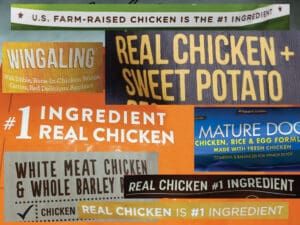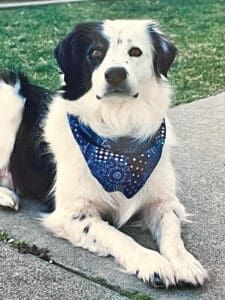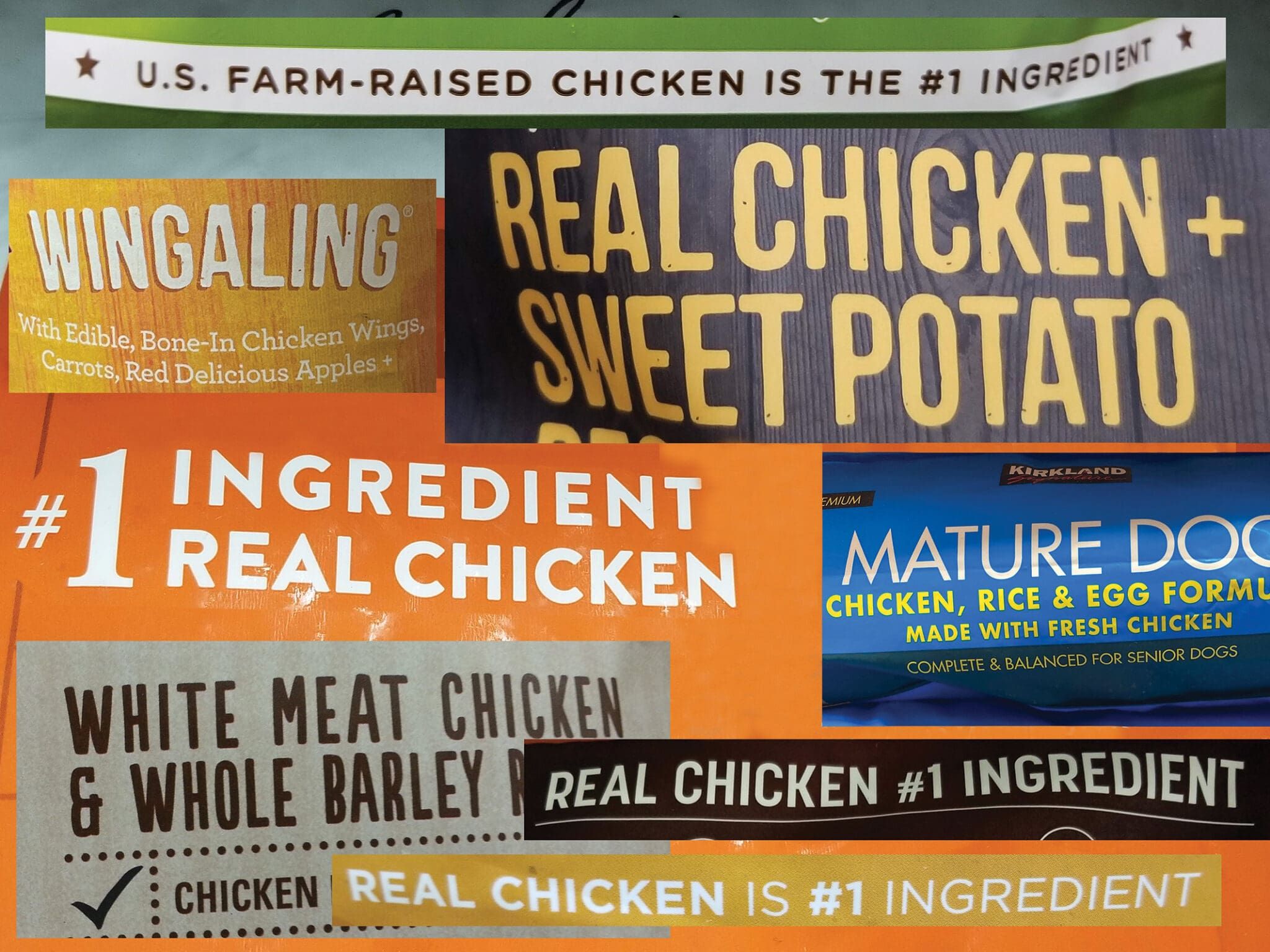
Dogs who are allergic to chicken in their food face a particular challenge: In order to be comfortable, they need a diet that contains no chicken, but chicken is the most common animal protein used in dog food. This means that the number of chicken-free dog foods is small relative to the number of dog foods overall.
Even so, it should be easy to find a diet that does not contain chicken, since all pet foods are required to list their ingredients, and today, every pet food maker has a website where all of their products are described.
However, chicken is so common in pet food that it’s sometimes detectible in foods that do not list chicken on their ingredients list, but is present as a result of cross-contamination in pet production facilities. A 2022 study, “Detection of Chicken DNA in Commercial Dog Foods,” found that chicken is one of the most common undeclared animal species on pet food labels.
So what’s a dog owner to do?
- First, you need to determine that your dog is truly allergic to chicken, by using an elimination diet.
- If the allergy is confirmed, find a chicken-free dog food, chicken-free treats, chicken-free toothpaste, and chicken-free supplements (if you use them).
If you are confident that you have eliminated every source of chicken in your dog’s diet, and yet the dog continues to display allergy symptoms, take these steps:
- Quiz (interrogate?) everyone in the family to find out if it’s possible that your dog is being fed something he isn’t supposed to have: treats from that drive-through coffee kiosk? McNuggets stolen from the kids?
- Contact the manufacturer of the food you are feeding to ask if it’s possible that formula changes have been made that are not reflected on the label of the product you bought. Be prepared with the date/code from the label of the product you are feeding.
- Try another manufacturer’s chicken-free dog food, because chicken-free dog foods that are made in a manufacturing facility that makes other products that do contain chicken can get cross-contaminated – and if this has happened once at that manufacturing facility, it will likely happen again.
- Try a diet with a hydrolyzed protein.
- Home-prepare your dog’s food.
A PERSONAL STORY OF A CHICKEN-ALLERGIC DOG

More than 20 years ago, I had a very itchy Border Collie named Rupert. I was aware that he was highly allergic to fleas and suspected that he also suffered from environmental allergies, because his itching was worse in the spring pollen season than at any other time.
At one point, I took Rupert to a holistic veterinarian who suggested that feeding kibble was the worst thing I could do to a dog with allergies. A fresh, raw diet, she said, would give Rupert access to the nutrients required for his body to heal and balance itself. She gave me a recipe for a diet based on raw chicken – the least expensive fresh meat – and I started feeding that to Rupert.
Within three days of being on the new diet, Rupert broke out in a firestorm of itching and scratching and biting himself. Overnight he developed an ear infection, which made him shake his head so hard that he developed an aural hematoma (a broken blood vessel in the ear flap). His usually floppy ear was standing up and so obviously painful that he was walking around with his head turned sideways, whimpering.
Cue the giant emergency vet bill! Surgery to drain the ear and tightly pack and bandage the ear to prevent further damage to the blood vessels. Steroids to stop his itching. Antibiotics for the ear and the hotspots he chewed into himself. And of course a cone to stop him from further damaging himself.
In the aftermath of that event, another veterinarian suggested that I should try feeding Rupert an elimination diet, comprised completely of ingredients he had never been fed before. In an elimination diet, you feed a novel protein source and a novel carbohydrate, and nothing else. This vet suggested buffalo meat and quinoa, both of which were available at our local Whole Foods.
Rupert’s baseline of constant, mild itching stopped within a week. And he didn’t scratch or lick the entire time I had him on this diet. His coat, which was always a tad thin and raggedy, started looking thicker. He was resting well and his eyes and ears were clear. It was obvious that something in his diet had been contributing to his allergy symptoms.
I started reviewing the ingredients lists of all the foods I had ever fed him, looking for ingredients in common – and this was before every pet food company had websites where you could find the ingredients; I had to visit pet food supply stores in person to flip over bags and write down the ingredients. To my surprise, I found that there was one ingredient common to every food that Rupert had ever been fed: chicken. I thought back to our ill-fated raw food diet trial of raw chicken. Poor Rupie! The evidence was strong that he was allergic to chicken, and I had tried him on a diet with a TON of it.
When you use an elimination diet, once your dog stops itching and is stable, you add one ingredient at a time back to his diet, waiting two to three weeks to see if he has an adverse response before adding another ingredient. I was so convinced that chicken was the problem, that instead of adding one ingredient at a time, I just looked for a dog food that contained no chicken. I found one that was comprised mainly of beef and barley. I started him on that food and held my breath, in case there was an ingredient in the new food that was also problematic. But Rupert stayed itch-free. It felt like a miracle!
For the rest of his life, Rupert would respond to any ingestion of chicken with a burst of itchiness for a day or two. But as long as I made sure he was chicken-free (and flea-free, of course), his skin remained clear and his coat thick and shiny. Even the springtime pollen didn’t bother him like it had when he was exposed to daily servings of chicken and pollen.
Only an elimination Diet Can confirm Food Allergy
Food allergies are relatively uncommon in dogs; only an estimated 1% to 2% of dogs exhibit a true hypersensitivity reaction to certain foods.
An allergic or hypersensitive reaction is when the dog’s immune system overreacts to a normally harmless substance and produces antibodies to it. Among those few dogs who have a true food allergy, the most common source of hypersensitive reactions is some sort of protein, with beef being the most common, followed by dairy products, chicken, and wheat gluten.
The most common sign of a food allergy in dogs is pruritus (intense itching). Dogs may display behavior that indicates that their skin is particularly itchy on their face, ears, feet, abdomen, and/or around their anus, though they may just be itchy all over. This itchiness can appear at any time of year – which helps distinguish a food allergy from a seasonal environmental trigger such as pollen or mold spores.
In addition, a dog with a food allergy may suffer from gastrointestinal (GI) signs such as vomiting and diarrhea, increased frequency of defecation (more than three times per day), soft-formed stool, tenesmus (the feeling that they need to poop even when they don’t, as evidenced by posturing without producing any feces, brought on by irritation of the nerves involved in pooping), flatulence, and loud or rumbling noises coming from his gut.
The gold standard for diagnosing food allergies is a diet elimination trial, wherein a dog is fed a novel animal protein – ideally, one he’s never been fed before – and a novel carbohydrate source. Every other source of food is withheld; only those two ingredients should cross his lips for the period of the trial.
Distinguishing Hypersensitivity (Allergy) from Other Adverse Reactions to Food
A true food allergy in a dog causes an exaggerated or inappropriate immunologic response to what should be a innocuous substance. But a dog can have other adverse responses to food that can cause symptoms that look similar to those of allergy.
A food intolerance can result from the absence of specific enzymes needed to digest a food substance, as with lactose intolerance, which can cause diarrhea, soft-formed stool, flatulence, and a loud gut. It may also result from an abnormality in the body’s ability to absorb nutrients.
Only a properly conducted food elimination trial, followed by a controlled dietary re-challenge with previously fed foods, can accurately diagnose a food allergy. Blood, saliva, and skin tests for food allergies often fail to produce results that are consistent with clinical reactivity.
If, after eight to 12 weeks, his allergy symptoms have ceased, a single ingredient can be added back into his diet, and that diet is fed for about two weeks while he is closely observed for allergy symptoms. If signs of allergy reappear, that ingredient is added to a list of ingredients to which he is allergic and should not receive. If, though, he continued to enjoy a lack of symptoms, one more ingredient is reintroduced to his diet under observation. This single-ingredient addition and observation continues indefinitely until you know what ingredients he’s allergic to.
Be aware that dogs who have a food allergy are more likely to suffer from an allergy to fleas and environmental allergies, too. You’ll need to maintain scrupulous flea-control for your dog and be mindful of his exposure to environmental allergens such as pollen and dust mites.
How to Find a Chicken-Free Food
The easiest way to find a chicken-free dog food is to use WDJ’s searchable databases (available to paid subscribers only).
To search for dry foods, go to WDJ’s list of approved dry dogs foods.
To search for canned products, go to WDJ’s list of approved canned dog foods.
To search for freeze-dried products, go to WDJ’s list of approved freeze-dried and dehydrated foods.
Once at the database of your choice, click on “add filters” (on the top left-hand side of the table of products). Then use the drop-down menus to change the text in the first box (“Where”) to “ingredients”, the second box to “does not contain”, and type “chicken” into the third box. You can then click “submit,” or add more filters if you are seeking to exclude other ingredients or products with a specific maximum amount of fat, or wish to find products below a certain price point.
Currently, there are 424 dry foods on our Approved Foods list, 406 chicken-free canned foods, and 169 chicken-free freeze-dried diets. Since our lists take in products at a wide price range, to accommodate dog owners of varying means, the products themselves will range in cost and quality, from moderate/good to quite expensive/great. Remember: The most expensive food is not always the best food, nor the best product for your dog.
Of course, you can also visit your favorite local pet supply store and ask for help finding a suitable chicken-free food for your dog.
Feed a Hydrolyzed Diet
The proteins in hydrolyzed diets have been tremendously altered through a water-based process called hydrolysis. Hydrolysis breaks down the protein into its constituent amino acids, which are less recognizable to the body’s immune-system sentries and thus far less likely for the dog’s body to react to them, but allows dogs to take in important nutrients. Hydrolyzed diets were first brought to the market by Purina in 1998, with Hill’s and Royal Canin following with hydrolyzed products within a few years.
The hydrolyzed diets on the market today include (note that these are all available by veterinary prescription only).
Each of these companies offer a canned and a dry version of their products.
Note that the companies who are large enough to have innovated these diets are not necessarily the ones that use fresh, whole ingredients in their foods. All of the ingredients in these diets (not just the proteins) tend to be highly processed and selected for high digestibility, so their ingredients lists don’t read as super appealing.
For example, the first five ingredients in Hills z/d dry dog food are corn starch, hydrolyzed chicken liver, hydrolyzed chicken, powdered cellulose, and soybean oil – not the most delicious, healthy-sounding food.
However, if one of these diets transforms your itchy, uncomfortable, raggedy-looking dog into a calm non-itchy dog with a nice coat, don’t fret about the ingredients or formula. The proof is in the pudding – or rather, the food’s performance; your dog’s comfort should be paramount.
Home-PreparE Your Dog’s Diet
Making your dog’s food (and treats!) at home is the best way to ensure he doesn’t eat chicken or any other ingredients to which he’s allergic.
Making your dog’s food is not rocket science, but you do need a reliable guide to ensure that the food you make contains an appropriate amount of calories and essential nutrients, in the proper amounts and proportions for a complete and balanced diet. Each meal does not need to be complete and balanced, but balance over time must be achieved to prevent deficiencies or excesses.
We suggest working with your veterinary nutritionist to determine your dog’s approximate energy requirements, and the proportions of protein, fat, and carbohydrates (if any) you should strive to provide in your dog’s food. You can develop recipes for complete and balanced home-prepared diets for your dog at the website Balance.It.
A chicken-free home-prepared diet – in addition to assiduous control of your dog’s snacks and treats – will offer your chicken-allergic dog the best chance of a comfortable, itch-free life.
